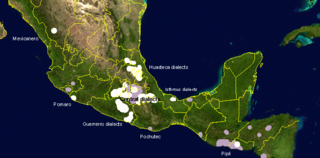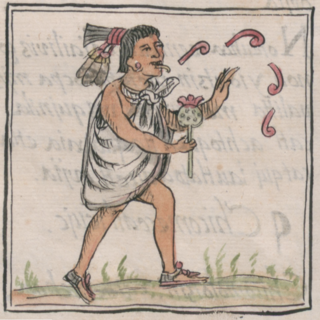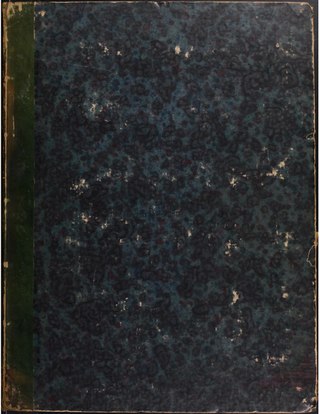Related Research Articles

Uto-Aztecan, Uto-Aztekan or Uto-Nahuatl is a family of indigenous languages of the Americas, consisting of over thirty languages. Uto-Aztecan languages are found almost entirely in the Western United States and Mexico. The name of the language family was created to show that it includes both the Ute language of Utah and the Nahuan languages of Mexico.

Plateau Penutian is a family of languages spoken in northern California, reaching through central-western Oregon to northern Washington and central-northern Idaho.

The Nahuan or Aztecan languages are those languages of the Uto-Aztecan language family that have undergone a sound change, known as Whorf's law, that changed an original *t to before *a. Subsequently, some Nahuan languages have changed this to or back to, but it can still be seen that the language went through a stage. The best known Nahuan language is Nahuatl. Nahuatl is spoken by about 1.7 million Nahua peoples.

Northern Paiute, endonym Numu, also known as Paviotso, is a Western Numic language of the Uto-Aztecan family, which according to Marianne Mithun had around 500 fluent speakers in 1994. Ethnologue reported the number of speakers in 1999 as 1,631. It is closely related to the Mono language.
Cora is an indigenous language of Mexico of the Uto-Aztecan language family, spoken by approximately 30,000 people. It is spoken by the ethnic group that is widely known as the Cora, but who refer to themselves as Naáyarite. The Cora inhabit the northern sierra of the Mexican state Nayarit which is named after its indigenous inhabitants. A significant portion of Cora speakers have formed an expatriate community along the southwestern part of Colorado in the United States. Cora is a Mesoamerican language and shows many of the traits defining the Mesoamerican Linguistic Area. Under the General Law of Linguistic Rights of the Indigenous Peoples, it is recognized as a "national language", along with 62 other indigenous languages and Spanish which have the same "validity" in Mexico.

The Tarahumara language is a Mexican indigenous language of the Uto-Aztecan language family spoken by around 70,000 Tarahumara (Rarámuri/Ralámuli) people in the state of Chihuahua, according to an estimate by the government of Mexico.
Tepehuán (Tepehuano) is the name of three closely related languages of the Piman branch of the Uto-Aztecan language family, all spoken in northern Mexico. The language is called O'otham by its speakers.
Pochutec is an extinct Uto-Aztecan language of the Nahuan branch which was spoken in and around the town of Pochutla on the Pacific coast of Oaxaca, Mexico. In 1917 it was documented in a monograph by Franz Boas, who considered the language nearly extinct. In the 1970s another investigator found two speakers around Pochutla who still remembered a few of the words recorded by Boas.
Ópata is either of two closely related Uto-Aztecan languages, Teguima and Eudeve, spoken by the Opata people of northern central Sonora in Mexico and Southeast of Arizona in the United States. It was believed to be dead already in 1930, and Carl Sofus Lumholtz reported the Opata to have become "Mexicanized" and lost their language and customs already when traveling through Sonora in the 1890s.
The Kawaiisu language is a Uto-Aztecan language spoken by the Kawaiisu people of California.
Proto-Nahuan is a hypothetical daughter language of the Proto-Uto-Aztecan language. It is the common ancestor from which the modern Nahuan languages have developed.

Aztec–Tanoan is a hypothetical and undemonstrated language family that proposes a genealogical relation between the Tanoan and the Uto-Aztecan families. In some forms, Aztec–Tanoan has also included the Zuni isolate. This proposed classification has not been definitively demonstrated, largely because of slow progress in the reconstruction of the intermediate stages of the two language families involved, but is still considered promising by many linguists. The grouping was originally proposed by Edward Sapir in his 1921 classification, but it was not until 1937 that supporting evidence was published by Benjamin Lee Whorf and G. L. Trager. Their proposal included some 67 proposed cognates, but subsequent reviews have found most of them to be unconvincing. A small number of their proposed cognates do seem to have some merit and in his 1997 review of the hypothesis Lyle Campbell states that the proposal is not implausible but requires detailed study. A recent article by Jane H. Hill argues that the evidence cited for the genetic relation by Whorf and Trager is better understood as a result of language contact between the Uto-Aztecan and Tanoan proto-languages.

Nahuatl, Aztec, or Mexicano is a language or, by some definitions, a group of languages of the Uto-Aztecan language family. Varieties of Nahuatl are spoken by about 1.7 million Nahua peoples, most of whom live mainly in Central Mexico and have smaller populations in the United States.
Proto-Uto-Aztecan is the hypothetical common ancestor of the Uto-Aztecan languages. Authorities on the history of the language group have usually placed the Proto-Uto-Aztecan homeland in the border region between the United States and Mexico, namely the upland regions of Arizona and New Mexico and the adjacent areas of the Mexican states of Sonora and Chihuahua, roughly corresponding to the Sonoran Desert and the western part of the Chihuahuan Desert. It would have been spoken by Mesolithic foragers in Aridoamerica, about 5,000 years ago.
Michoacán Nahuatl is the name given to a variety of Nahuatl language spoken by the Nahua Michoacan on the Pacific Coast of Mexico in Michoacán. It is a dialect of Nahuatl, a language of the Uto-Aztecan family. It is the westernmost variant of this language, although the Uto-Aztecan family is spread farther north, central, south and east. It has around 9000 speakers which mainly reside in rural communities in the municipalities of Aquila, Apatzingán Pomaro and Maruata in Michoacán de Ocampo, which coexist with the Purepecha language speakers. The Michoacan Nahuatl is one of many Nahua dialects, notably with regard to the central dialects which include tl in certain words, usually Michoacan. For example, the word for "man" in Central Nahuatl is tlacatl, whereas in Michoacan Nahuatl it is lacal.

The Serran or Serrano-Gabrielino languages are a branch of the Uto-Aztecan language family that comprises the Serrano language, extinct Kitanemuk language, and Tongva, all indigenous to southern California. The branch has been considered to be part of the Takic subgroup, but there is doubt about the validity of Takic as a genetic unit, the similarities between the languages classed as Takic possibly being due primarily to borrowing.
The Tarahumaran languages is a branch of the Uto-Aztecan language family that comprises the Tarahumara and Huarijio languages of Northern Mexico. The branch has been considered to be part of the Taracahitic languages, but this group is no longer considered a valid genetic unit.

The Cahitan languages is a branch of the Uto-Aztecan language family that comprises the Yaqui and the Mayo languages, both of Northern Mexico. The branch has been considered to be part of the Taracahitic languages, but this is no longer considered a valid genetic unit.
References
- ↑ Tubar at Ethnologue (25th ed., 2022)

- ↑ Lionnet, A. (1978). El idioma tubar y los tubares: según documentos inéditos de CS Lumholtz y CV Hartman. Univ. Iberoamericana.
- ↑ Stubbs, B. D. (2000). The Comparative Value of Tubar in Uto-Aztecan. Uto-Aztecan: Structural, Temporal, and Geographic Perspectives: Papers in Memory of Wick R. Miller by the Friends of Uto-Aztecan, 357.